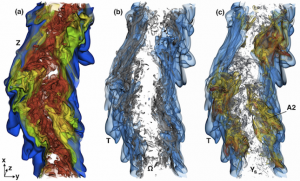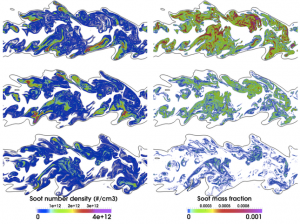Details
Modeling of turbulent combustion is severely hindered by a lack of accurate and complete experimental data, which would allow deficiencies in the models to be assessed and corrected. In particular, the formation of pollutants, such as soot, is a complex, non-linear, and multiscale process characterized by the interaction of molecular and turbulent mixing with a multitude of chemical reactions occurring on disparate timescales.
The use of direct numerical simulation (DNS) featuring a state-of-the-art description of the underlying chemical and physical processes has contributed greatly to the development of combustion models in recent years. Soot emissions are an undesirable by-product of rich combustion in technical combustion devices such as internal combustion engines, jet engines, and industrial burners. Since soot poses important health and environmental risks, there is significant interest in improving our understanding of soot formation and growth, with the aim of reducing harmful emissions.
Goals
- Analyze soot formation and growth in flames.
- Characterize the interactions between chemistry, soot formation, and fluid mechanics, with special emphasis on the turbulent regime.
- Formulate accurate new models of the inception and growth of soot in flames.
- Develop closure strategies for Large Eddy Simulation and Reynolds Average Navier-Stokes modeling of turbulent combustion and pollutant formation.
Methods
This work is based on DNS of soot formation in flames. Simulations of turbulent flames were performed in realistic, three-dimensional, temporally evolving turbulent nonpremixed planar jets. These recent DNS studies represent the state of the art in DNS of turbulent combustion in terms of scope, physical modeling, and numerical methods for massively parallel reactive flow simulations. The calculations featured 500 million grid points and consumed more than 50 million cpu-hours on 32,768 cores of an IBM Blue Gene/P system, generating in excess of 100 TB of data. Soot particles and aggregates were described by their volume (V) and surface area (S) using a method of moments. A detailed chemical mechanism, which includes polycyclic aromatic hydrocarbons, was employed for the first time in three-dimensional simulations of turbulent sooting flames. The spatial advection of soot moments was solved with a recently proposed Lagrangian particles scheme.
Results
The formation, growth, and transport of soot is investigated via large scale numerical simulation in three-dimensional turbulent non-premixed n-heptane/air jet flames at a jet Reynolds number of 15,000. Soot precursors are found to be affected more significantly by the scalar dissipation rate than by temperature or by the presence of other species controlled by oxidation chemistry. While the mixture fraction and temperature fields show fairly smooth spatial and temporal variations, the sensitivity of soot precursors to turbulent mixing causes large inhomogeneities in the precursor fields, which in turn generate even stronger intermittency in the soot fields. A strong correlation is apparent between soot number density and the concentration of naphthalene. However, while soot mass fraction is usually large where naphthalene is present, pockets of fluid with large soot mass are also frequent in regions with very low values of the naphthalene mass fraction. From the analysis of Lagrangian statistics, it is shown that soot nucleates and grows mainly in a layer close to the flame and spreads on the rich side of the flame due to the fluctuating mixing field, resulting in more than half of the total soot mass being located at mixture fractions larger than 0.6. Only a small fraction of soot is transported towards the flame and is completely oxidized in the vicinity of the stoichiometric surface [Attili, Bisetti, Mueller, and Pitsch, Comb. Flame, 161, 1849 (2014)].

The effect of Damköhler number on turbulent nonpremixed sooting flames was investigated in three-dimensional n-heptane/air jet flames at a jet Reynolds number of 15000 and at three different Damköhler numbers. At the highest Damköhler number, local extinction is negligible, while flame holes are observed in the two cases with lowest Damköhler number. Compared to temperature and other species controlled by fuel oxidation chemistry, naphthalene is found to be affected more significantly by the Damköhler number than by temperature or by the presence of other species controlled by fuel oxidation chemistry. Consequently, the overall soot mass fraction decreases by more than one order of magnitude for a fourfold decrease of the Damköhler number. The overall number density of soot particles is approximately the same in each case, but its distribution in mixture fraction space is very different. The total soot mass growth rate was found to be proportional to the Damköhler number. In the two cases with lowest Da number, soot leakage across the flame was observed. Leveraging Lagrangian statistics, we conclude that soot leakage is due to patches of soot that cross the stoichiometric surface through flame holes [Attili, Bisetti, Mueller, and Pitsch, Proc. Combust. Institut., in press (2014)].

These results show the leading order effects of turbulent mixing in controlling the dynamics of soot in turbulent flames. Given the difficulties in obtaining quantitative data in experiments on turbulent sooting flames, this simulation provides valuable data to guide the development of Large Eddy Simulation and Reynolds Average Navier Stokes models.
References
- F. Bisetti, A. Attili, and H. Pitsch. Advancing predictive models for particulate formation in turbulent flames via massively parallel direct numerical simulations. Phil. Trans. R. Soc. A, 372: 20130324 (2014). doi: 10.1098/rsta.2013.0324
- A. Attili, F. Bisetti, M. E. Mueller, and H. Pitsch. Damköhler number effects on soot formation and growth in turbulent nonpremixed flames. Proc. Combust. Inst., in press (2014). doi: 10.1016/j.proci.2014.05.084
- A. Attili, F. Bisetti, M. E. Mueller, and H. Pitsch. Formation, growth, and transport of soot in a three-dimensional turbulent non-premixed jet flame. Combust. Flame, 161, 1849 (2014). doi: 10.1016/j.combustflame.2014.01.008
- A. Attili and F. Bisetti. Application of a robust and efficient Lagrangian particle scheme to soot transport in turbulent flames. Comput. Fluids, 84 164 (2013). doi: 10.1016/j.compfluid.2013.05.018
